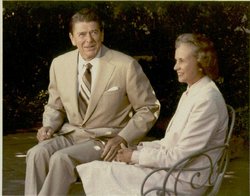Sandra Day O'Connor
|
|
Justice Sandra Day O'Connor (born March 26, 1930) has been an Associate Justice of the Supreme Court of the United States since 1981. She was the first woman to serve on the Court. Due to her case-by-case approach to jurisprudence and her relatively moderate political views, she has in recent years been the crucial swing vote of the Court. She has been called "the most powerful woman in America." Forbes Magazine designated her the fourth most powerful woman in the United States and the sixth most powerful in the world. [1] (http://www.forbes.com/lists/2004/08/18/04powomland.html)
Life and history
O'Connor was born in El Paso, Texas and grew up on a cattle ranch in southeastern Arizona. She later wrote a book about her childhood experiences on the ranch, "Lazy B," with her brother, H. Alan Day. She attended Stanford University, where she received her B.A. in economics in 1950. She continued at Stanford for her LL.B., graduating in two years (instead of the customary three), serving on the Law Review, and graduating third out of 102 in the class of which William Rehnquist was valedictorian.
In spite of her accomplishments at law school, no law firm in California was willing to hire a woman, although one firm did offer her a position as a legal secretary. She therefore turned to public service, taking a position as Deputy County Attorney of San Mateo County, California from 1952-1953 and as a civilian attorney for Quartermaster Market Center, Frankfurt, Germany from 1954-1957. From 1958-1960, she practiced law in the Maryvale area of the Phoenix metropolitan area, and served as Assistant Attorney General of Arizona from 1965-1969. She was appointed to the Arizona State Senate in 1969 and was subsequently reelected to two two-year terms. In 1973, she became the first woman to serve as a state senate majority leader in any state. In 1975, she was elected judge of the Maricopa County Superior Court and served until 1979, when she was appointed to the Arizona Court of Appeals by a Democratic governor. During her time in Arizona state government, she served in all three branches. On August 19, 1981, President Reagan, who had pledged during the 1980 presidential campaign to appoint the first woman to the Supreme Court, nominated her as an Associate Justice of the Supreme Court, replacing the retiring Potter Stewart. She was confirmed by the Senate unanimously on September 21 and took her seat September 25.
She married John Jay O'Connor III in 1952 and has three sons.
Law in the center of politics
The first woman appointed to Supreme Court, O’Connor has become one the most-watched justices on the Court. She is part of the federalism movement and approaches each case as narrowly as possible, avoiding generalizations which might later “paint her into a corner” for future cases. Although she formed part of the conservative axis during the later years of the Burger Court, with the departure of the last members of the liberal Warren Court, she is now regarded as occupying the ideological center. It is both O’Connor’s dedication to asserting her judicial power over that of other federal institutions and her pragmatic circumspection that has given her a deciding centrist vote for many of the Rehnquist Court’s cases. Some have called her 'the most powerful woman in the country.'
On December 12, 2000, O’Connor joined with six other (ruling to stop the ongoing Florida recount) and four other (ruling to allow no further recounts) justices to rule on the case in which effectively decided the 2000 election in favor of George W. Bush (Bush v. Gore). Never before had such a decision been made by a U.S. court. O'Connor had been quoted by Newsweek magazine as expressing dismay to friends on the night of the election, when Al Gore was reported to have won several key states, and critics suggested that she did not want Gore to appoint her successor. Some charged that the Supreme Court made a power grab through its decision. Others note that the Court specifically restricted the precedent-setting effect of the decision by holding, "Our consideration is limited to the present circumstances, for the problem of equal protection in election processes generally presents many complexities."
Justice O'Connor has played an important role in other notable cases, including Webster v. Reproductive Health Services and Lawrence v. Texas, and was the deciding vote which upheld the McCain-Feingold campaign finance bill, as well as the vote which upheld affirmative action policies on college campuses. Some suggest that, in making her decisions, O’Connor not only considers the merits of the case and her personal views, but also focuses too much on the prevailing politics of the day. Others counter that she holds very nuanced views and decides each case on its merits. In any event, she is frequently the justice to whom oral and written arguments are directed because she is so frequently the deciding vote.
Justice O'Connor was successfully treated for breast cancer in 1988, and there has long been speculation that she might retire from the Court.
On February 22, 2005, with Chief Justice Rehnquist and Justice John Paul Stevens absent, O'Connor presided over oral arguments in the case of Kelo v. City of New London, becoming the first woman to preside over an oral argument before the Supreme Court.
External links
- Official Supreme Court biographies of all current justices (http://www.supremecourtus.gov/about/biographiescurrent.pdf) (PDF format)
- The OYEZ Project's biography (http://www.oyez.org/oyez/resource/legal_entity/102/biography) by a Northwestern University law professor
- LookSmart - Sandra Day O'Connor (http://search.looksmart.com/p/browse/us1/us317916/us53716/us62703/us10211698/us551221/us551229/us541140/) directory category
- Yahoo - Sandra Day O'Connor (http://dir.yahoo.com/Government/U_S__Government/Judicial_Branch/Supreme_Court/Justices/O_Connor__Sandra_Day/) directory category
| Preceded by: Potter Stewart | Associate Justice of the Supreme Court of the United States September 25, 1981 – present (a) | Succeeded by: — |


